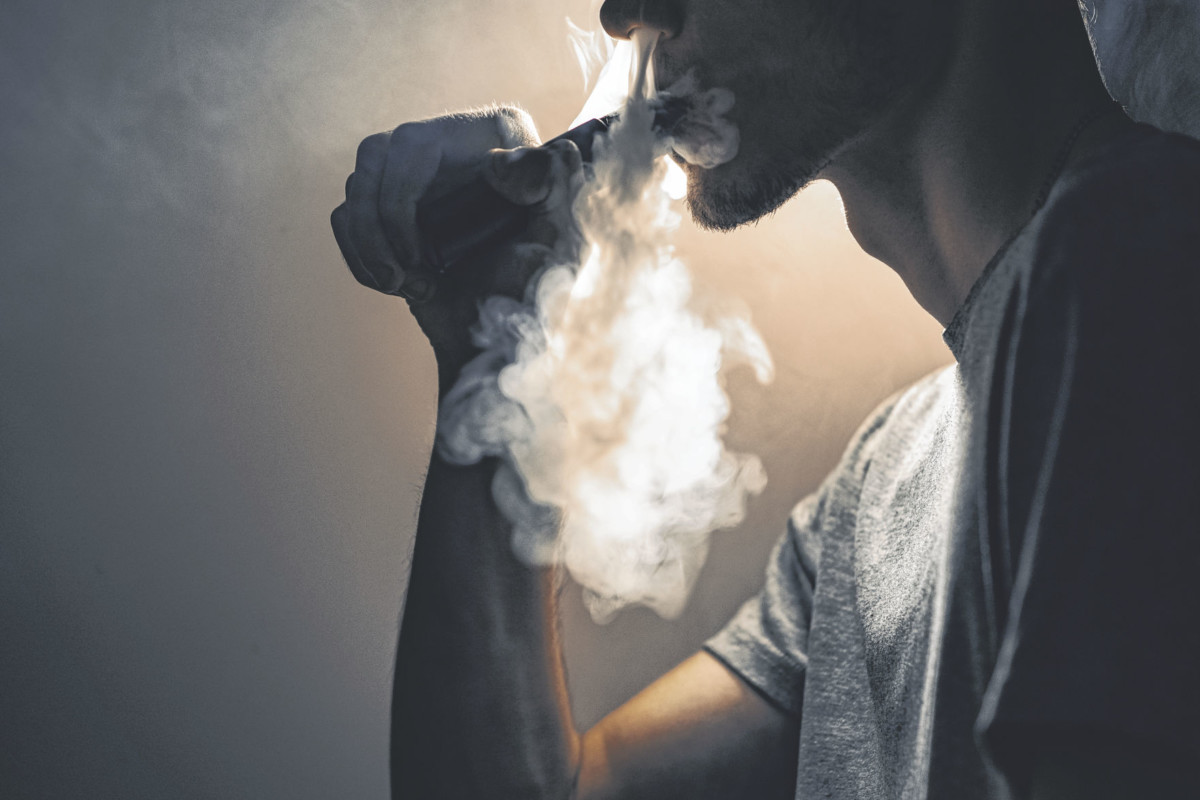On Friday, a 19-year-old employee at Indiana Vapor Labs LLC contacted his bosses to see if a new law would terminate him from employment.
Owners Ashley and Joseph Grizzle didn’t fully understand the question because nobody from the state or federal government had contacted the Seymour-based business about any major changes coming before the New Year.
“We started doing research and contacted our local ATC (Alcohol and Tobacco Commission) officer, and he said he couldn’t give us any guidance and we needed to go to the U.S. Food and Drug Administration website,” Ashley said.
What the small business owners found on the site surprised them.
The federal legal age to purchase tobacco products had been increased from 18 to 21 after President Donald Trump signed a law into effect Dec. 20. The provision is part of a $1.4 trillion spending bill and will affect both traditional tobacco products and e-cigarettes.
According to the FDA, the implementation of the law is now in effect on a federal level.
“It is now illegal for a retailer to sell any tobacco product, including cigarettes, cigars and e-cigarettes, to anyone under 21,” the FDA’s website states.
On its website, the FDA states it will provide additional details on the change as they become available.
It, however, doesn’t give direction as to what businesses need to do in the meantime.
“We’re confused by how to comply,” Ashley said. “There were no formal letters or anything. Nothing has been given to us. No phone call. Nothing. Over the night, we had to let our employee go. We have lost one employee, and right now, it’s back to not knowing what we have to do until the law is stated. Right now, we are refusing customers under the age of 21.”
The Grizzles aren’t the only ones trying to navigate the changes, as locals in Jackson County are coming to grips with the new law.


Roots of the change
More than 16 million Americans are living with a disease caused by smoking cigarettes, and for every person who dies because of smoking, at least 30 people live with a serious smoking-related illness, according to the Centers for Disease Control and Prevention.
Studies by the CDC show that more than 480,000 Americans die from smoking cigarettes each year, which is about 1,300 deaths per day.
The CDC states if cigarette smoking continues at the current rate among youth, 5.6 million of today’s Americans younger than 18 will die early from a smoking-related illness.
According to the Indiana State Department of Health, there are approximately 7,000 adults in Jackson County who smoke, which is about 23% of the population. Jackson County is about 4% over the state average.
While smoking remains the leading cause of preventable death in the United States, fewer youth are using traditional tobacco products.
According to the CDC, cigarette smoking has decreased among middle and high school students from 2011 to 2019.
In high schools, cigarette smoking has dropped 15.8%, cigars have decreased 11.6% and smokeless tobacco use has gone down 7.9%.
In 2019, about 12 of every 100 middle school students and about 31 of every 100 high school students reported current use of a tobacco product.
Also this year, nearly one in every four middle school students (24.3%) and more than half (53.3%) of high school students said they had never tried a tobacco product.
Lin Montgomery, public health coordinator for the Jackson County Health Department, said changing the age is a good policy long term.
“Any time you can delay the onset, it’s a good strategy,” she said. “Even if one person decides that they’re too young for it, that will decrease the chances of them ever starting.”
Targeting vaping
Many feel the new law isn’t targeting cigarettes or smokeless tobacco, but vaping products.
Both nationally and locally, health officials have seen a significant increase in the use of vaping products by teens. According to the latest federal data, 27.5% of high school students reported using e-cigarettes.
The number of middle and high school students using e-cigarettes rose from 3.6 million in 2018 to 5.4 million in 2019, the CDC says.
Monitoring the Future, a study put on by the National Institute on Drug Abuse in high schools, conducted a report on teen vaping from a federal survey.
The study found that one in four 12th-graders, one in five 10th-graders and nearly one in 10 eighth-graders say they have vaped nicotine in the past month. This year’s survey included 42,531 students from 396 public and private schools nationwide.
Keith Williams, a school resource officer for Seymour Community Schools, said vaping is a problem at the schools.
“We don’t see tobacco hardly at all anymore. It has all gone toward the vaping,” Williams said. “It is so easy for kids to get ahold of it. You can just order them online, unlike cigarettes, and kids know that. Raising the age to 21, I don’t believe it will help that.”
Williams estimated 95% of the tobacco-based offenses at the schools involve vaping. He said he has seen it at the middle school, and he wouldn’t be surprised if it has reached elementary-aged children.
“What is going to help that is parents being more involved with their children and knowing what they’re doing, them realizing their children don’t have as many rights as they think,” he said. “Children have the rights their parents give to them until they’re 18. Children have the right to be safe and taken care of but not what they can do in their own house.”
Lung injury outbreak
In June, an outbreak of lung injuries related to vaping were reported across the country, creating national headlines.
However, cases of vaping-related injury have been declining since September.
The CDC said the outbreak of the lung injuries, known as EVALI, seems to be coming to an end. Laboratory data by the CDC has shown that vitamin E acetate, an additive in some THC-containing vaping products, is closely associated with the injuries.
Vitamin E acetate was found in the lungs of 48 of the 51 patients the CDC sampled from 16 states.
The cartridges containing the harmful mix of chemicals are or were sold on the black market, typically online or on the street.
On Dec. 20, the FDA and Drug Enforcement Administration announced they seized 44 websites advertising the sale of illicit vaping cartridges.
The action, which is part of Operation Vapor Lock, is part of ongoing work by federal, state and local authorities to investigate the supply chain of vaping products associated with recent lung injuries.
Ashley Grizzle said she fears younger people will start buying more from the black market now that the law has changed.
She said her and her husband’s business prides itself in safe, educational practices that need to be taught to people who vape.
“I feel like a lot of people are going to go black market,” she said. “People are going to go back to making it from scratch. With e-liquid, you can buy all the ingredients online and make it at home with no age limit.”
In September, Trump put out “some very strong recommendations” regarding the sale of flavored e-cigarettes. At the time, administration officials said the agency would remove all non-tobacco-flavored vaping products from the market.
“My sales dropped when Trump communicated that they were going to ban flavors,” Ashley said. “I would say we lost between 30 and 40% of income.”
Some believe raising the age is a tradeoff to not banning flavored liquids.
Ten days after the law went into effect, Indiana Vapor Labs was still turning underage customers away from its counter.
“We’ve had a lot of issues,” Ashley said. “We’ve had a lot of people call. We’ve had to tell people who just turned 18 that bought starter kits that they can’t buy any product now. They’ve invested their money, and now, they can’t follow up with their device.”
Ashley said she isn’t opposed to the age change but wishes there would have been some sort of communication between the government and her business.
“We usually have an older clientele,” she said. “I really hope it doesn’t hurt us in the long run as far as safety and vaping. We truly try to help people quit smoking. I wish they would have done it 30 years ago when tobacco was the problem. Now that vaping has made a stand that it’s not going anywhere, they want to make it 21 and older.”
Local officials react to change
While the federal law has gone through, Indiana hasn’t changed its own laws yet as far as the age of sale of tobacco products.
However, high-ranking officials have supported the idea of creating a law in recent times, and many businesses have made the change in compliance to the federal rule.
On Dec. 10, during his 2020 Next Level Agenda presentation in Terre Haute, Gov. Eric Holcomb said he wanted to make it a priority to raise the smoking age to 21. Sen. Todd Young also introduced the Tobacco to 21 Act this past April.
Jackson County Prosecutor Jeff Chalfant and local police are trying to figure out the best way to address the change.
“Presumably, Indiana will pass a statute essentially recognizing the FDA’s rules that you need to be 21 to purchase tobacco,” Chalfant said. “Until the Indiana legislature does that, the only guidance we have is what the feds say.”
Chalfant said he needs to see more action taken by the state to make the laws clear.
“At this point, I don’t see that it’s a crime in Indiana if you are 18, 19 or 20,” he said. “I don’t think it’s going to affect my office until Indiana passes a law that criminalizes possession or purchase of tobacco of someone who is 18, 19 or 20.”
Penalties could be assessed to businesses that aren’t complying to the 21-and-over policy, but each county could view the law differently.
District 69 State Rep. Jim Lucas, R-Seymour, said he believes the state will support the federal law.
The lawmaker said he doesn’t agree with the policy and that the government has created a quagmire.
“I am against it 100%,” Lucas said. “We recognize 18-year-olds as being old enough to join the military and volunteer their lives to fight for our country, to fight for freedom. They can vote, they can be charged with a felony, they can go to a university and take on hundreds of thousands of dollars of unforgivable debt, but yet we can’t trust them to smoke? It’s hypocrisy. It’s wrong. You’re either old enough to do all those things or you’re not.”
Chalfant said the FDA doesn’t typically operate in this manner.
“Typically, the FDA, when they intend to take action, they have public notice, hearings and study groups and issue decisions that have a future effective date,” he said. “This seems a little backwards from normal. It appears people are being informed of new regulations by social media.”
Lucas said he feels bad for small business owners and that people’s good intentions are getting in the way of constitutional rights.
“It’s another hot mess created by government,” he said.
By the numbers
Youth and tobacco use — Centers for Disease Control and Prevention
“Current use” is determined by respondents indicating they have used a tobacco product on at least one day during the past 30 days.
Tobacco use among high school students in 2019
Tobacco product;Overall;Girls;Boys
Any tobacco product;31.2%;30.6%;31.8%
Electronic cigarettes;27.5%;27.4%;27.6%
Cigarettes;5.8%;4.1%;7.3%
Cigars;7.6%;6.2%;9.0%
Smokeless tobacco;4.8%;1.8%;7.5%
Hookahs;3.4%;3.2%;3.6%
Pipe tobacco;1.1%;–;1.5%
Tobacco use among middle school students in 2019
Any tobacco product;12.5%;12.4%;12.5%
Electronic cigarettes;10.5%;10.8%;10.2%
Cigarettes;2.3%;2.5%;2.1%
Cigars;2.3%;2.0%;2.7%
Smokeless tobacco;1.8%;–;2.7%
Hookahs;1.6%;1.8%;1.3%
